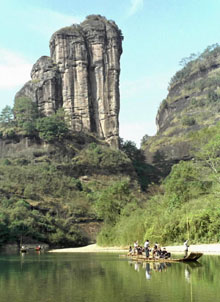

 |
 |
||||||||||||||
|
|
|||||||||||||||
|
|
Saturday, December 04, 1999, updated at 13:35(GMT+8)
East China's Mount Wuyi and the 1,000-year-old Dazu Rock Carvings in southwest China's Chongqing Municipality have become the latest additions to the 21 Chinese cultural and natural sites listed on UNESCO's World Heritage List. According to a UNESCO (United Nations Educational, Scientific and Cultural Organization) official in Beijing, there are 630 sites in 118 countries on the world heritage list. Mount Wuyi in Fujian Province is described as "an outstanding conservation area" and "a refuge for a large number of animals and plants". The Dazu Rock Carvings in the steep hillsides of Dazu County contain an exceptional number of rock carvings dating from the 9th to 13th centuries. Material released by UNESCO's Beijing office said the rock carvings "are remarkable for their high aesthetic qualities, their rich diversity of subject matter, both secular and religious, and provide a glimpse into the life of China during this period." The World Heritage Committee set up funds for protecting cultural and natural sites around the world in 1976. Cultural sites are required to have historic, artistic, archeological, scientific and anthropological value, while natural sites must offer distinct ecological and geographical features. The Convention on the Protection of World Cultural and Natural Heritage, which UNESCO adopted in 1972 requires all its members to preserve and safeguard listed sites which are protected during times of war. China joined the convention in 1985 and filed an application to join the Convention the following year. Six Chinese sites were added to the list in 1987-- Mount Taishan in Shandong Province; the Great Wall and the Palace Museum in Beijing; the Mogao Grottos in Dunhuang, Gansu Province; the Tomb of Qinshihuang in Xi'an, capital of Shaanxi Province, and the Peking Man site near Zhoukoudian in southwest Beijing. The Potala Palace in Lhasa, Tibet Autonomous Region, the Lushan Mountains in Jiangxi Province, gardens in Suzhou, Jiangsu Province, and Lijiang in Yunnan Province are also on the list. China submits a limited number of applications each year. Presently, Chinese is focusing on adding several other sites to the list including the eastern and western mausoleums of the Qing Dynasty (1644-1911), the Dujiangyan Irrigation Project and Mount Qingcheng in Sichuan Province. Printer-friendly Version Chinese VersionBack to top Copyright by People's Daily Online, All rights reserved |
Relevant Stories Internet Links |